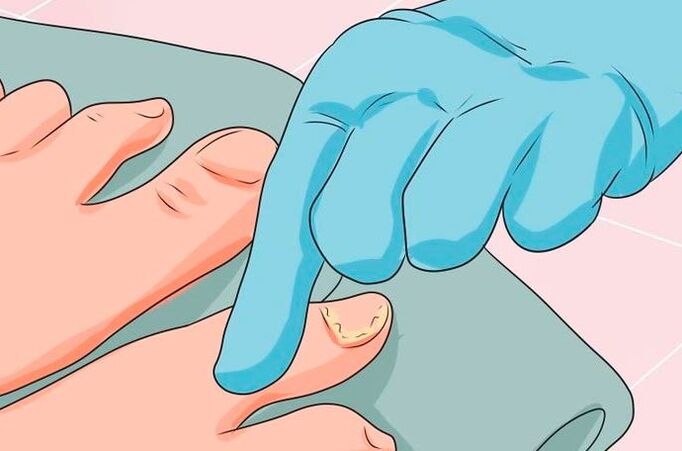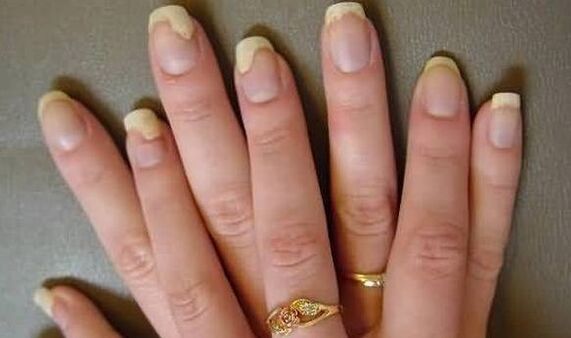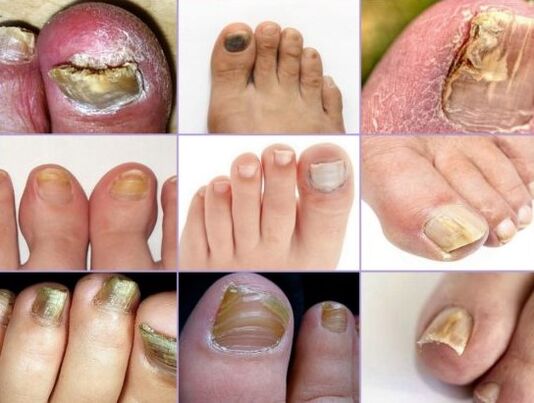Onnikmicosis is fungal nail plate damage. The disease can be caused by dermatophytic fungi or microsporia. Fungi negatively affect the construction base of the nail - Keratin and, gradually eating, cause changes in deformation.

There are the following types of ONY micromiquites:
- Normatorophically. Change the color of the nail, the layout of the stripes and stains.
- Hypertrophic. Only a color change appears, but also mild deformation. The most common nail is deformed from Ivica.
- Onycholitic. The nail was destroyed, atrophied and rejected.
The leg nails on the leg nails appear not only for reducing immunity. About 70% of people are infected from a sick person, and they are most often relatives. The smallest scales of skin from the feet fall on home items, and in contact with healthy nail or skin tissues infects a healthy person.
The most common infection occurs through:
- Opera.
- Sponge.
- Towels.
- Rugs.
- Shoes.
- Manicure accessories.
When you visit the beach, sauna and baths without slippers, there is a high risk of infection of leg fungi. With high moisture and temperature, the infection occurs much more often.
It is especially careful to be in public places where people go barefoot. The fungi is resistant to both low and high temperature, and retain their sustainability in the beach on the beach.
Healthy tissues gradually influence fungus. Much depends on the type of pathogen, but some signs allow us to distinguish several main phases of the development of ONY micromicosis:
- Normorophic, or initial. At this stage, there is no pronounced manifestations, it is difficult to notice the fungus infection. The nail becomes matt, its color can change a bit, small cracks, irregularities on the surface occur. Burning and itching can be felt. This period is easy to confuse with other diseases: psoriasis, the changes in the liver. Therefore, it is recommended to contact a dermatologist to confirm the diagnosis.
- The hyperttrophic form occurs if the measures are not undertaken in the initial phase. Symptoms become more pronounced. Nail sinks and darkens, the shape of the board is deformed, falls apart and destroys.
- Atrophic or neglected. It appears when the infection spreads on the cuticle, the latter refuses, inflammation and swollen. The entire nail plate surface changes its color, is completely separated from the bed. Treatment can be inefficient, the nail is not always saved because of its atrophy.

Nail signs:
- The nail plate begins to change the shade, it becomes boring. As a result loses a healthy pink color. When the fungus is parased on the surface, the nail becomes white or yellowish. So most often happens on your fingers. With other types of damage, the nail can take over any shade: from greenish, gray to black.
- Thickening or exhausting nail plate - When you notice that the nail thickness has changed, this is a clear sign of fungal damage. At the same time, the nail plate loses elasticity, it becomes rough, hard or reverse too soft, starts to break up. The normal thickness of the nail on the fingers does not exceed 0, 5 mm, leg nails up to 1 mm.
- Stratification of nail plate, lag behind the nail bed surface is a sign of an advanced phase of the disease when the structure of the changes is nailed. Becomes loose, uneven, covered with furrows.
- Uneasiness - to realize that the fungus appeared on nails with unpleasant sensations that accompany this disease. There is a difficult itching, sometimes a painful sensation.
- Unpleasant odor - This symptom is especially characteristic of ony micromicose on the legs of the toes. When they start uncomfortable, despite the regular implementation of hygienic procedures, you should see a doctor.
Nail Fungi is often accompanied by an extremely unpleasant odor
General symptoms of the disease are listed above. But as the specifically interaccine manifestation depends on the type of fungus, which impressed the nail plate.
Each variety of mycosis has typical signs:
- Fungus fleet - leads to the fast states of nail plate. It breaks, starts pissing out of the nail bed. The shadow of the nail first becomes yellowish and then buying brown colors. In a neglected disease form, skin around the nail drum, blush.
- Molds - Parasit on the surface of the nail plate, without penetrating deeper. Thanks to that, this type of disease is easier to treat from others. The main sign of the disease is a change in the color of the nail. The shadow can be any: from white, green to gray, black. If you do not start the correct treatment in a timely manner, the fungus spreads to other nails and even the skin. There is a serious itch, pain, especially when walking.
- Dermatophyte - develops when the nail is affected by Trichophyton spp. , As well as Epidermophyton SPP and Microsporarum SPP. The first signs of this disease - stains or stripes of gray, yellowish shades are formed on the nail plate. As the disease advances, their amount increases, and the nail begins to swing.

Dermatophyte one of the usual shapes of fungus nails
To know what mycosis hit the nail very important for proper treatment. The active components of most pharmacological medications are designed to destroy a certain type of fungus.
Onhomycosis begins with the lying of insignificant parts of the nail, so many people initially pay attention to the change of shades and form stains. In the absence of treatment, Micosa is expanding rapidly, affects all large areas of the infected nail, crossing healthy nails and infects others.
There are 3 phases of the development of mycosis nails:
- The initial phase - income without clearly expressed symptoms, unpleasant sensations, such as itching, pain, are often absent. Small stains, strips, intertwined that barely distinguish themselves appear on the nail plate. The easiest to notice them on the thumb.
- The second or progressive phase of the onnicmicosis - the number of stains and grooves increases, they become large and already clearly noticeable. The color of the nail plate changes, fades and begins to deform.
- Advanced phase - The nail plate completely loses aesthetic appearance, is excessively thick or very fragile. The color of the nail becomes yellow, brown, green, black. It is released, there is a risk of complete loss of nail.
The first signs of the nail fungus presence
Earlier it is possible to detect onychomicosis, as much as possible to get rid of these diseases quickly. With competently operational therapy, the body is minimally suffering, so when the first symptoms of mycosis appear, you must consult a doctor.
The first signs of mycosis nails appear almost after infection. If after visiting public places like a swimming pool, sauna, a shower, a gym, beach, nails faded, they started slightly.
Healthy nails are practically not subject to fungi infection. It starts to develop rapidly when they are only on damaged nail tiles.
National medications
There are many folk medications to help curve nails affected by fungi in the initial phase. Think about efficient, but simultaneously recipes.
Sometimes ordinary iodine can handle the fungus quickly
- Jod - daily until the symptoms disappear, apply 1 drop of iodine 5% to affected nails. The procedure is performed in the morning, as well as in the evening. More material on iodine treatment.
- 1 teaspoon of iodine, vinegar, glycerol is mixed and diluted with 6 teaspoons of water. The resulting mixture in 10 days in a series rubs nails. The composition on the nail plate must be left overnight.
- Ortić - Prepare a bath with a dilution of 1 part of vinegar 9% with 8 hot water parts. Bang in your legs or weapons 20 minutes. Spend 7 procedures every other day. More material on the treatment of vinegar.
- Grease from the egg - Put raw chicken egg in the shell in a glass and pour 9% vinegar to the top. When the shell is dissolve, remove the remaining movie and mix an egg with vinegar. The resulting mixture is applied twice a day on the affected areas 2-3 weeks.
Chicken egg ointment is also quite effective against mycoose nails

- Hydrogen peroxide - diluted in 2 liters of water 2 buckets of peroxide hydrogen 3%. Sinned hands or legs, depending on where the fungus is localized for 20 minutes. Repeat the procedure for 7-10 days in a row.
- Compression peroxide - for impregnating cotton lining with peroxide, attach it to nails on which there are signs of fungi. Before that arm or legs must be scared in the Soda bath. To prepare it, 1 teaspoon of soda is diluted in 1 liter of water. Stit on top is wrapped with cellophane or food folk and is left for 60 minutes. This is necessary so that peroxide is not evaporated. Repeat the procedure for 10-14 days twice a day.
- Propolis tincture - wet cotton wipe in the volume alcohol tincture 20% and fasten to affected areas. Hold the lotion until the composition is dried. Repeat daily to recovery. 1-2 Procedures are long enough.
- Washing powder - The method is suitable for leg nail treatment. It is necessary to dissolve 100 g wash powder, which contains a lot of ports, in 2 liters of water. Stick in such baths 15 minutes. Repeat 10-14 procedures while symptoms disappear.
- Garlic - Cut a peeled comb garlic, wet in salt, then resolve nail plate. Repeat twice a day before the symptom of symptoms.
- Ammonia - diluted in 1 glass of water 1 tablespoon of ammonia. The resulting solutions impregnates with a cotton fabric. It is necessary to wrap legs or arms and leave this compression at night. Repeat the procedure for 7 days a day.
- LUK - ground arc to the consistency of the gas and fasten to affected nails for 30 minutes. Repeat twice a day before recovery.
Chopped onion will help you give you back your nails a healthy look
- Mix chamomile, sage for sage, you can take dry or fresh plants. At night put the resulting composition in your finger or glove. Plants should be changed every night. Repeat the procedure in combination with other recipes until the symptoms of the fungus disappear.
- Borinic acid - cotton swamps impregnated with side acid are applied to pre-set nails. You have to keep a lotion for 30 minutes. The procedure is repeated 10 days in a row a day.
- Celand oils and tea - mix these products in equal stake, soak the gauze bandage with the resulting composition and apply it to nails for 20 days in a row in 45 minutes. The recipe is contraindicated in pregnant women.
- Soda - dilute soda with a small amount of water to Gruela consistency. Apply him to nails for 20 minutes, then rinse with warm water 10-12 days twice a day.
- Apple vinegar - dilute it with olive oil. The required proportion is 2 parts of vinegar up to 1 part of the oil. Apply a mixture to affected nail plates until the nail is growing completely.
- Tea oil - In the nail, apply a few drops of oil on the nails, while the areas of nail plates are affected by fungi completely grow.
- Verba - Grind 500 g Shooting young willow, pour 2 liters of water, bring to boiling. From the completed deckcoice three times a week make hand baths or leg baths for 20 minutes to recovery.
- Nettle - beer 3 tablespoons of 400 ml of water. With this decoction, place wet tampons and apply them to nail slabs twice a day before recovery.
- Protect mountain ash leaves and put your nails a thick layer, then wrap it with a baking movie for 30 minutes. Repeat the process a day 12-14 days.

- Mushrooms of foot skin.
- Reducing immunity.
- Family members who suffer from a fungal defeat.
- Staros old age.
- Diabetes.
- The presence of microtrows and the bourgeon.
- Increased leg sweats.
- Unknown and bad shoes.
- The habit of walking barefoot in public places.
- Accommodation and work in wet air conditioning.
- Long-term wearing of artificial nails.
- General health.
- Sensitivity to infection.
- Leveliness level and thermal background.
- The type of nail plate (nails on their fingers become slower).
- Distal submarine onychomycosis.
- Side-onnicmicosis.
- White surface onychomicosis.
- Proximal drawer onychomicosis.
- Total dystrophic onnikhychosis.
How can you get fungi infection?
Infection with mikozu nail can appear anywhere: from the place of public visits to your home. It is transferred directly from people to people, as well as through facilities with which a person suffering from mycosis contacted. Mushroom penetrates microts, bruises, other damage.

Places where you can infect Mikozo:
- Public places where people often go barefoot, especially if moisture increases there. In such a microclimate, Mikoz long holds life. Examples of such institutions are souls in fitness centers, saunas, bathroom.
- Chest of drawers in shops, sports complexes and other places.
- Manicure rooms - If the master does not process tools poor after a person or pedicure is made by a person with fungi, there is a very high probability that the next client is infected with this disease infected.
- Visits and at home - when a person puts on clothes, shoes where fungi is left, uses a towel that has previously used onychomicosis. Mushroom can be on nails if you walk barefoot on the floor.
- The beach - in the beach on the beach always has a lot of fungi. If you walk barefoot, they will penetrate the microcracks, and the diseases cannot be avoided. In addition, you can infect the beach through the deck chair.
- Public transport - over the handle to which the patient touched.
- Trade - While effort on a nude foot of shoes, which previously measured the patient's nail fungus.
There are great chances of infecting fungus nails in public transport
You should be extremely edited in the above mentioned places to avoid infection.


















